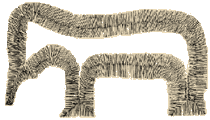
|
THE SPALDING
RESEARCH PROJECT |

|
Dale R. Broadhurst's "Spalding Papers"
"Index" -- 01 02 03 04 08 09 10 11 12 13 14 15 16 -- "Home"
Paper 12 - Part IIIb
Commentary on M. D. Bown's
Book of Mormon / Spalding MS Parallels
Numbers 15-24

Revision 0a: September, 1998
Editorial and Bibliographic Information
Go Back to Intoduction & Index [ pp. 01 to 06 ]
|
ITEMIZED LIST OF PRESUMED SIMILARITIES Between Spaulding's "Manuscript Story" and the Book of Mormon Specific and single similarities have been isolated, listed separately, and numbered, with the paralleling citations from each work following. Whenever possible, direct quotations have been made. Only when necessary has discussion been utilized, and here care has been taken that the duplicating references are amply and accurately recorded -- but even so, errors no doubt will appear. This method of listing parallels is cumbersome perhaps, and has involved exceeding labor in preparation; but it seems to have the merit of providing direct comparison between the two works with a minimum of vagueness. "MS" refers to Solomon Spaulding's "Manuscript Story," the edition used being published at the Millennial Star Office, Liverpool, England, 1910, 116 pages. "BM" refers to the BOOK OF MORMON, and the edition used was published by the Church of Jesus Christ of Latter-day Saints, Salt Lake City, 1920, 522pp. Please Read These Notes First: 1. All additions to Bown's original paper are shown in blue. 2. Commentary here as a summary; For full commentary follow the links. 3. The Commentator's Personal Ratings of Bown's Parallels: * poor parallel or not a parallel: should have been dropped Some On-line Textual Resources: 1. Search the Book of Mormon: LDS and RLDS texts (side-by-side scrolling comparison) 2. Search the Book of Mormon: Current LDS edition (includes phrase search) 3. Search the Book of Mormon: 1830 edition (includes concordance functions) 4. Search the Spalding MS: Special e-text version (includes concordance functions) 5. Search the Spalding MS: Special e-text (side-by-side with 1830 Book of Alma) 6. Search the Spalding MS: LDS 1910 edition (the edition used in Bown's citations) 7. Read Holley's book: Book of Mormon: A Closer Look (Spalding / BoM Comparisons) 8. Search the Bible: King James version (includes Apocrypha & concordance functions) 9. Search Ethan Smith's Book: View of the Hebrews (includes concordance functions) |
Go Back to: Parallels 01-14 [ pp. 07 to 11 ]
|
15. Both works include an account of the departure of a small party from the Old World. 7 MS -- The party led by Fabius left Rome, bound for Britain. BM -- Lehi and his family departed from Jerusalem, wandering in the wilderness eight years, until they arrived at the sea coast, from which point they left for the New World ("Promised Land"). Comment summary on item #15: *** Both the Roman and Lehite parties of God-fearing men and women departed from an Old World capital city, little knowing what adventures awaited them. Both were sent on their way by high authority and both at first had fair sailing. There are several other sub-paralles linking the two groups, and the list could be lengthened by inclusion of commonalities both shared with the Jaredites. (more comments on item #15) 16. The people crossed the ocean in a sailing vessel. MS -- Fabius was to ". . . sail in a vesel and return when she returns Preparation was made instantly and we sailed -- the vessel laden with provisions for the army -- cloathing, knives, and other impliments." (p. 4) BM -- "And it came to pass after we had all gone down into the ship, and had taken with us our provisions and things which had been commanded us, we did put forth into the sea and were driven forth before the wind towards the promised land." (1 Nephi 18:8) Comment summary on item #16: *** Presumably the two ships were similar-sized ocean-going vessels. Both craft had been prepared for a long voyage and sailed after being provisioned for the voyage. True ocean-going ships would have been rare or non-existent at this time, although some ships did sail beyond the Mediterranean and Arabian seas. (more comments on item #16) 17. A great storm arose. MS -- They "had now arrived near the coasts of Britain when a tremendous storm arose & drove us into the midst of the boundless Ocean." (p. 4) BM -- ". . . there arose a great storm, yea a great and terrible tempest, and we were driven back upon the waters for the space of three days . . ." (1 Nephi 18:13) Comment summary on item #17: **** The great storms encountered in the Nephite and Jaredite crossings accomplish some of the same purposes for the narrative as does Spalding's tempest. The three accounts use a good deal of the same phraseology in relating their stories of the stormy ocean crossing. And in all three stories the reader senses God's directing presence in both the storm and its aftermath. (more comments on item #17) 18. The voyagers became frightened, and were lost. MS -- "Soon the whole crew became lost & bewildered -- They knew not the direction of the rising Sun or polar star... Their minds were filled with consternation and dispair." (p. 4) BM -- "Wherefore, they knew not whither they should steer the ship... and began to be frightened exceedingly lest they should be drowned in the sea . . ." (1 Nephi 18:13) Comment summary on item #18: **** While the parallel can be succinctly stated, the common phraseology found in the Roman, Nephite, and Jaredite records at this point renders several complex and undoubtedly significant textual commonalties. A portion of this common phraseology can be traced to earlier English texts, and this fact adds even more strength to Bown's parallel. (more comments on item #18) 19. The storm continued many days. MS -- "After being driven five days with incredible velocity before the furious wind, the storm abated in its violence . . . On the sixth day after, the storm wholly subsided . . ." (p. 5) BM -- "And after we had been driven back upon the waters for the space of four days..." (1 Nephi 18:15) Comment summary on item #19: *** The storm is essentially the same in all three records, both in its attributes and in its effects. The Romans and Lehites endured the furious winds for about the same length of time. Like the Romans, the Lehites were "driven" from their original course. The "driven back" Lehites, like Spalding's Romans, may have unintentionally crossed the Atlantic Ocean. (more comments on item #19) 20. They prayed to God for the storm to cease. MS -- "Then it was that we felt our absolute dependence on that Almighty & gracious Being who holds the winds and storms in his hands -- From him alone could we expect deliverance. To him our most fervent desires ascended -- prostrate and on bended nees we poured forth incessant supplications . . ." (p. 4) BM -- ". . . my brethren began to see that judgments of God were upon them, and that they must perish save that they should repent of their iniquities . . . And it came to pass that I prayed unto the Lord." (1 Nephi 18:15, 21) Comment summary on item #20: **** Members of all three parties unceasingly praised or prayed to the same God while crossing the stormy seas to the New World. This show of faithfulness spared the Romans and Lehites from a "watery" tomb or grave. Despite some minor differences, the three stories are essentially the same at this point (more comments on item #20) 21. Then the storm ceased. MS -- The men prayed and then "After being driven five days before the furious wind, the storm abated in its violence." (p. 5) BM -- ". . . and after I had prayed the winds did cease, and the storm did cease, and there was a great calm." (1 Nephi 18:21) Comment summary on item #21: *** The reader understands, in each of the three stories, that the cessation of the storm comes through divine intervention. In contrast to the Book of Mormon stories, Spalding is likely presenting a parody of Christian prayer and an awkward attempt at expressing subtle, anti-religious humor. So, while there is a parallel here, there are also some substantial differences. (more comments on item #21) 22. They sailed further several days and then landed. MS -- "On the fifth day after this we came in sight of Land . . . We anchored within a small distance from shore . . . We now found ourselves once more on terra firma." (p. 5-6) BM -- "And it came to pass that after we had sailed for the space of many days we did arrive at the promised land; and we went forth upon the land . . ." (1 Nephi 18:23) Comment summary on item #22: ** There is little substance to the parallel described by Bown. The Romans sail for five more days and enter the Delaware estuary. A day or so later they land in the vicinity of today's Wilmington. After "the space of many days" the Lehites also arrive somewhere in the Americas. Bown misses seeing the element of divine guidance in both landings. Spalding introduces his first example of religious practice, with a human-voiced predictive revelation. Many other parallels could be drawn here between the Spalding scenario and events recorded in the Book of Mormon. (more comments on item #22) 23. They landed on the American Continent. MS -- Spaulding entitled Chapter I: "An Epitomy of the Authors life & of his arrival in America." (p. 3) There is no doubt that the Roman party landed on the North American continent. U.S. lakes and rivers are mentioned by name. BM -- There is no direct evidence in this work that Lehi and his party actually landed on the American continent, although certain indirect evidence is held to substantiate this claim, such as the narrow neck of land but a day's journey in width from sea to sea (Cf. Alma 63:5; 50:34; Mormon 2:29; 3:5, etc.), which is taken to be the present Isthmus of Panama. Joseph Smith is said to have reported that the party "traveled nearly a south, south-east direction until they came to the nineteenth degree of north latitude; then, nearly east to the sea of Arabia, then sailed in a southwest direction, and landed on the continent of South America, in Chili, thirty degrees south latitude." 8 Comment summary on item #23: *** The Romans landed near present-day Wilmington, but we are not told where the Lehites landed. They did not encounter Spalding's "Deliwan" Indians or any other native inhabitants, so far as we know. The Romans arrive as castaways and long to return home; but the Lehites come as colonizers to a land prepared especially for them. (more comments on item #23) 24. There were many rivers and lakes in the land. MS -- The manuscript mentions the rivers Suscowah, Deliwah, Sciota, Ohio, Mississippi, and Owaho; also lakes Eri, Mischigan, and Ontario, BM -- "And they did travel to an exceeding great distance, insomuch that they came to large bodies of water and many rivers." (Helaman 3:4) The Sidon river was important in Nephite history and [is] frequently mentioned (some 37 times, according to the CONCORDANCE). Also mentioned are "waters of Mormon" (Mosiah 18:8, "waters of Ripliancum" (Ether 15:9), "waters of Sebus," (Alma 17:34), and so on. Comment summary on item #24: ** Bown moves from the Lehites' unknown landing spot, to a description of some other unknown Book of Mormon location. Although the Lehite-Nephite events may have occurred in relatively small region, we have nothing in them like Spalding's clear-cut story locations. Some reseachers have placed part of the Book of Mormon Geography in the Great Lakes region. If this is so, the possible parallel with Spalding's lakes and rivers would be an important one. But Bown offers almost no information in support of this possibility, or even in support of his own generalized statement. (more comments on item #24) Go to: item #25 |
Commentary on M.D. Bown: [Index] [parallels 01-14] < - > [parallels 25-47] [parallels 48-59]
[parallels 60-78] [parallels 79-99] [Bown's Notes] [Names Index] [Editorial & Bibliographic Info.]
Spalding Studies Home Page: [Introduction] [SRP] [Broadhurst Papers] [E-mail Site Host]
revision 0a: September, 1998